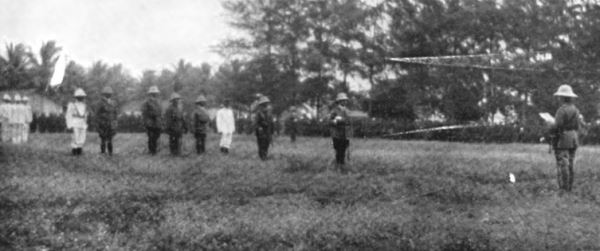| |
At nightfall on 12 September, Berrima landed the ANMEF infantry battalion at Rabaul. The following afternoon, despite the fact that the German governor had not surrendered the territory, a ceremony was carried out to signal the British occupation of New Britain. As recorded by MacKenzie:
At 3 o'clock on Sunday afternoon, September 13th the British flag was hoisted at Rabaul. The ceremony was held in an open space (now known as Proclamation Square) bordered by casuarina trees and over-looked by white tropical bungalows. Through the trees could be seen the blue waters of the bay sparkling in the sunlight, and the ships of the Australian fleet riding at anchor. All available troops, including a newly-enrolled native police force under British officers, were formed up on three sides of a square, facing the flagstaff, with the band of the Australia in the centre. The fourth side of the square was occupied by Rear-Admiral Patey, the officers of the Royal Australian Navy, and residents of Rabaul. Punctually at 3 o'clock the flag was broken by Lieutenant Basil Holmes and saluted by the troops, the warships at the same time firing a salute of twenty-one guns. The national anthem was sung; three cheers were given for the King; the military occupation of the Territory was formally proclaimed by the brigade-major, and the naval and military officers and troops, followed by the native police force, marched past in column of route and saluted the flag.
The German administration had withdrawn inland to Toma and at dawn on 14 September, HMAS Encounter bombarded a ridge near the town, while half a battalion advanced towards the town, supported by a field gun. After a parlay on 19 September 1914, the German forces in New Britain formally surrendered on 21 September 1914.
At the Proclamation ceremony on 12 September in Rabaul, the flag raised was the Union Jack, at that time almost as much an emblem of Australia as it was of His Brittanic Majesty the King in whose name the occupation/ possession of the German Proctectorate was proclaimed. The ceremony was conducted in Proclamation Square. It was witnessed by an array of soldiers, some New Guineans and it seems not many Germans. PNGAA contributors have written about the irony that the same Proclamation Square, some weeks later, being the centre of a ceremonial caning of some German civilians from New Ireland who had been found guilty of administering corporal punishment to an Englishman, the Reverend Cox, just days after the outbreak of war. [ For some details see articles in Una Voce: The Cox Incident and Cox and the Wenzels.]
About the attitude of the times, The Illustrated War News, 30 December 1914 conveys much with a single snap and caption:

A GERMAN ISLAND ADDED TO THE EMPIRE BY THE AUSTRALIAN FORCES: READING THE BRITISH PROCLAMATION AT RABAUL, NEU POMMERN
The Australian Squadron arrived at Herbertshöhe, Neu Pommern, on September 11. After some fighting, the Germans surrendered, and, two days later, the Union Jack was hoisted at Rabaul, the German capital. The proclamation was read by Major Francis Heritage (facing Colonel W. Holmes, the central figure in the photograph). For the benefit of the natives an address was given in amusing "pidgin" English (see the The Times, November 16). Neu Pommern (formerly New Britain) is just east of New Guinea.
|
